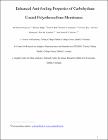| dc.contributor.author | Colavita, Paula | en |
| dc.contributor.author | Scanlan, Eoin | en |
| dc.date.accessioned | 2015-09-17T11:41:33Z | |
| dc.date.available | 2015-09-17T11:41:33Z | |
| dc.date.issued | 2015 | en |
| dc.date.submitted | 2015 | en |
| dc.identifier.citation | Angione M.D, Duff T, Bell A.P, Stamatin S.N, Fay C, Diamond D, Scanlan E.M, Colavita P.E, Enhanced Antifouling Properties of Carbohydrate Coated Poly(ether sulfone) Membranes, ACS Applied Materials and Interfaces, 7, 31, 2015, 17238 - 17246 | en |
| dc.identifier.other | Y | en |
| dc.identifier.uri | http://hdl.handle.net/2262/74601 | |
| dc.description | PUBLISHED | en |
| dc.description.abstract | Polyethersulfone membranes (PES) were modified with biologically active monosaccharides and disaccharides using aryldiazonium chemistry as a mild, one step, surface modification strategy. We previously proposed the modification of carbon, metals, and alloys with monosaccharides using the same method; herein we demonstrate modification of PES membranes and the effect of chemisorbed carbohydrate layers on their resistance to biofouling. Glycosylated PES surfaces were characterized using spectroscopic methods and tested against their ability to interact with specific carbohydrate-binding proteins. Galactose, mannose and lactose modified PES surfaces were exposed to Bovine Serum Albumin (BSA) solutions to assess unspecific protein adsorption in the laboratory and were found to adsorb significantly lower amounts of BSA compared to bare membranes. The ability of molecular carbohydrate layers to impart antifouling properties was further tested in the field via long term immersive tests at a wastewater treatment plant. A combination of ATP content assays, infrared spectroscopic characterization and He-ion microscopy (HIM) imaging were used to investigate biomass accumulation at membranes. We show that, beyond laboratory applications and in the case of complex aqueous environments that are rich in biomass such as wastewater effluent, we observe significantly lower biofouling at carbohydrate modified PES than at bare PES membrane surfaces. | en |
| dc.description.sponsorship | The authors would like to thank Dr. G. McManus for assistance with microscopy instrumentation and the Advanced Microscopy Laboratory for supporting HIM access; we also thank Mr. F Zen for his assistance with AFM. The authors are grateful to Dr. Aoife Gallagher and
21
Gordon Elliott from TCD and to staff at the Osberstown Wastewater Plant, for their support with field testing. This publication has emanated from research conducted with the financial support of Enterprise Ireland Grant No. CF/2012/2634; CF acknowledges support under the FP7 “Aquawarn” Project (SME-2013-1-605937). | en |
| dc.format.extent | 17238 | en |
| dc.format.extent | 17246 | en |
| dc.relation.ispartofseries | ACS Applied Materials and Interfaces | en |
| dc.relation.ispartofseries | 7 | en |
| dc.relation.ispartofseries | 31 | en |
| dc.rights | Y | en |
| dc.subject | Polyethersulfone membranes (PES) | en |
| dc.subject.lcsh | Polyethersulfone membranes (PES) | en |
| dc.title | Enhanced Antifouling Properties of Carbohydrate Coated Poly(ether sulfone) Membranes | en |
| dc.type | Journal Article | en |
| dc.type.supercollection | scholarly_publications | en |
| dc.type.supercollection | refereed_publications | en |
| dc.identifier.peoplefinderurl | http://people.tcd.ie/colavitp | en |
| dc.identifier.peoplefinderurl | http://people.tcd.ie/scanlae | en |
| dc.identifier.rssinternalid | 105810 | en |
| dc.identifier.doi | http://dx.doi.org/10.1021/acsami.5b04201 | en |
| dc.rights.ecaccessrights | openAccess | |
| dc.identifier.rssuri | http://www.scopus.com/inward/record.url?eid=2-s2.0-84939166207&partnerID=40&md5=e78f0bbe28ea11024d76b760fd2290b3 | en |
| dc.identifier.orcid_id | 0000-0003-1008-2874 | en |




